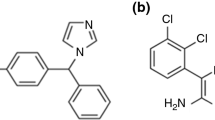Abstract
Dielectric Thermal Analysis (DETA) of drugs, proteins and amino acids reveals a strongly linear conductivity increase prior to and peaking at the melt, associated with dielectric viscoelastic properties of the material. Premelt onset and peak are shown to depend on thermal history. Comparisons of neat amino acid samples to samples heated to 150 °C; dried in a desiccator; or heated above their melting point and cooled show significant premelt and melt shifts. Melts are also correlated with phase transitions observed by Differential Scanning Calorimetry (DSC). Activation energies attributed to charging in the premelt for amino acids were typically 250 J/mole.







Similar content being viewed by others
References
Riga A, Alexander K. Electrical conductivity analysis/dielectric analysis differentiate physical chemical properties of drugs and excipients. Am Pharm Rev. 2006;6:45–50.
Riga A, Cahoon J, Pialet JW. Characterization of electrorheological processes by dielectric thermal analysis. In: Riga AT, Judovits L, editors. Materials characterization by dynamic and modulated thermal analytical techniques, ASTM STP 1402. West Conshohocken, PA: American Society for Testing and Materials; 2001. p. 139–56.
Cahoon J, Riga A, Lvovich V. Characterization of organic surfactants and dispersants by frequency-dependent dielectric thermal analysis and electrochemistry. In: Riga AT, Judovits L, editors. Materials characterization by dynamic and modulated thermal analytical techniques, ASTM STP 1402. West Conshohocken, PA: American Society for Testing and Materials; 2001. p. 157–73.
Wesolowski M, Erecińska J. Relation between chemical structure of amino acids and their thermal decomposition. J Therm Anal Calorim. 2005;82(2):307–13.
Kyte J, Doolittle RF. A simple method for displaying the hydropathic character of a protein. J Mol Biol. 1982;157(1):105–32.
Presswala L, et al. Discovery of bound and unbound waters in crystalline amino acids revealed by thermal analysis. J Therm Anal Calorim. 2008;93(1):295–300.
Matthews ME, et al. Dielectric classification of d- and l- amino acids by thermal and analytical methods. J Therm Anal Calorim. 2008;93(1):281–7.
Author information
Authors and Affiliations
Corresponding author
Rights and permissions
About this article
Cite this article
Matthews, M.E., Riga, A.T. Effects of thermal history on solid state and melting behavior of amino acids. J Therm Anal Calorim 96, 673–676 (2009). https://doi.org/10.1007/s10973-009-0036-1
Published:
Issue Date:
DOI: https://doi.org/10.1007/s10973-009-0036-1




